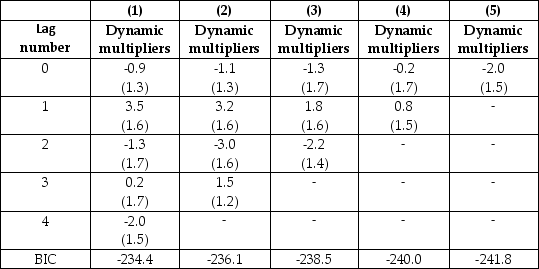Essay
One of the central predictions of neo-classical macroeconomic growth theory is that an increase in the growth rate of the population causes at first a decline the growth rate of real output per capita,but that subsequently the growth rate returns to its natural level,itself determined by the rate of technological innovation.The intuition is that,if the growth rate of the workforce increases,then more has to be saved to provide the new workers with physical capital.However,accumulating capital takes time,so that output per capita falls in the short run.
Under the assumption that population growth is exogenous,a number of regressions of the growth rate of output per capita on current and lagged population growth were performed,as reported below.(A constant was included in the regressions but is not reported.HAC standard errors are in brackets.BIC is listed at the bottom of the table).
Regression of Growth Rate of Real Per-Capita GDP on Lags of Population Growth,
United States,1825-2000
 (a)Which of these models is favored by the information criterion?
(a)Which of these models is favored by the information criterion?
(b)How consistent are these estimates with the theory? Is this a fair test of the theory? Why or why not?
(c)Can you think of any improved data to test the theory?
Correct Answer:

Verified
(a)BIC has a minimum for no lag and this...View Answer
Unlock this answer now
Get Access to more Verified Answers free of charge
Correct Answer:
Verified
View Answer
Unlock this answer now
Get Access to more Verified Answers free of charge
Q11: The distributed lag model is given by<br>A)Yt
Q11: To estimate dynamic causal effects, your textbook
Q15: Your textbook estimates the initial relationship between
Q16: In time series data, it is useful
Q17: A model that attracted quite a bit
Q19: Given the relationship between the two variables,
Q30: Ascertaining whether or not a regressor is
Q36: Your textbook presents as an example of
Q37: A distributed lag regression<br>A)is also called AR(p).<br>B)can
Q44: The concept of exogeneity is important because<br>A)it